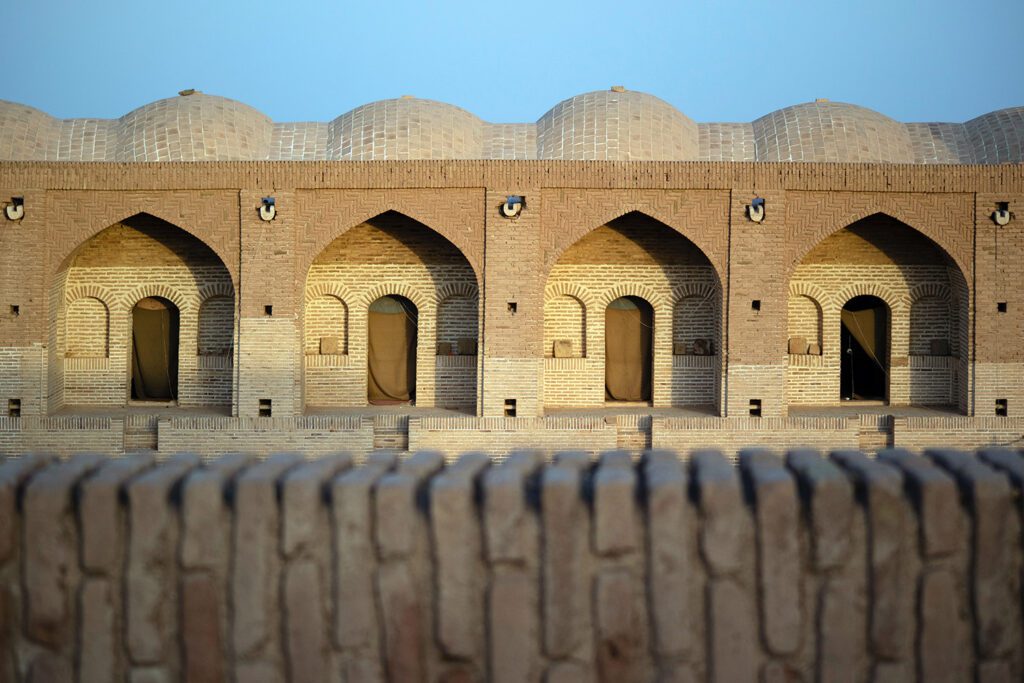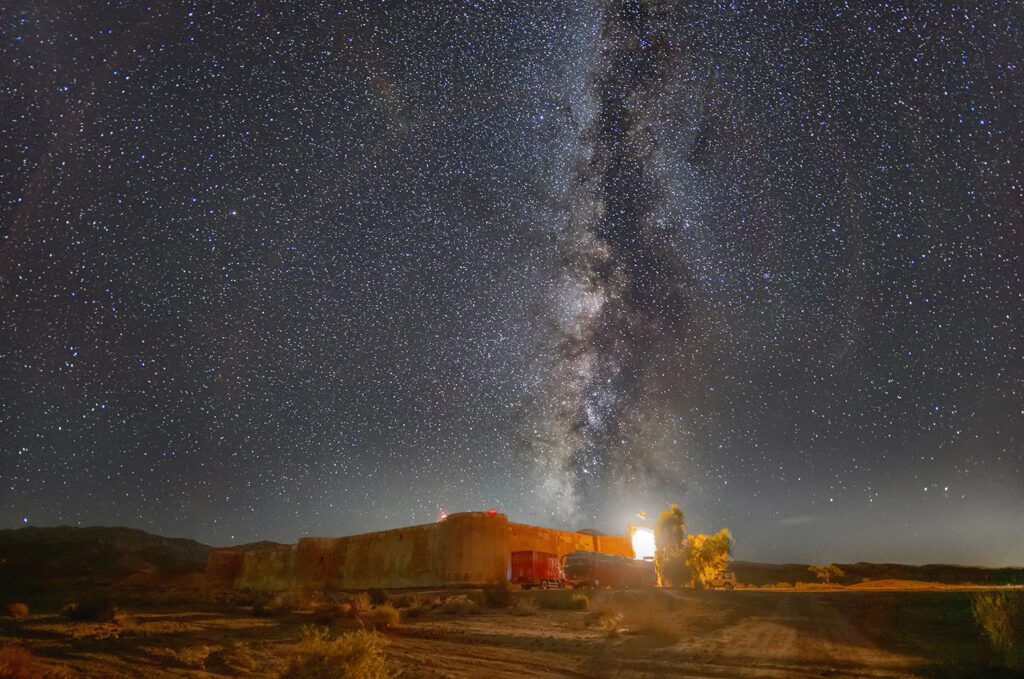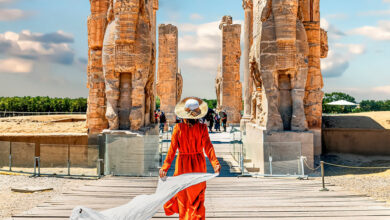Exploring Silk Road Caravanserais in Iran

The Silk Road was once a network of trade routes connecting East Asia to the Mediterranean world. Merchant caravans carried spices, textiles, and medicines for centuries in Central Asia.
Caravanserais – roadside inns providing a vital rest stop for weary traders and their camels and horses along the route were an integral part of this overland trade.
Scattered across modern-day Iran stand imposing yet haunting ruins of once-bustling caravanserais. These structures exemplify Persian architecture and engineering with their soaring arches, ornate brickwork, and clever designs built to withstand harsh desert elements.

Contents
The Vital Role of Caravanserais on the Silk Road
Caravanserais were crucial in facilitating trade along the Silk Road by providing safe lodging for caravan traders and animals as they traversed thousands of miles across continents. These roadside inns had several important functions:
Places of Repose
The arduous overland journey along the Silk Road traversed remote deserts and rugged mountains. Caravanserais served as welcome places of rest and recovery along the lengthy route. Traders stayed 1-2 nights to refresh travelers and animals before continuing.
Protection from Bandits
Traveling through isolated areas made caravans vulnerable to attacks by bandits. Caravanserais provided a place of safety behind thick walls and sturdy gates. Traders could camp without fear of assault.
Goods Storage
Merchants used caravanserais to store goods securely. The rooms served as warehouses protecting valuable wares until trades could be made at the destination markets.
Trade Centers
In addition to lodging, caravanserais became thriving marketplaces. Vendors gathered to buy and sell goods, exchange news, collect taxes and tariffs, and make business deals.
Maintenance Stops
The long trek resulted in damaged packsaddles, worn shoes, and limping camels. Onsite blacksmiths, wheelwrights, and animal doctors at caravanserais repaired essential equipment to keep caravans moving.
Impressive Examples of Persian Caravanserais
Dozens of historic caravanserais exist across Iran. Spanning different eras, here are some standout structures along the Persian Silk Road:
Zeyn-o-din Caravanserai
Built in 1695, the meticulously restored Zeyn-o-din Caravanserai amazes visitors with its monumental yet elegantly decorated pishtaq entrance, flanked by four impressive circular corner towers.
This 500-year-old Caravanserai is located 40 km outside Yazd City in the village of Mehriz, set scenically amidst the desert landscape.

Travelers can take a taxi from Yazd to visit this well-preserved Caravanserai, about a one-hour drive into the peaceful desert. Once there, tourists can explore the spacious inner courtyard surrounded by storerooms and wander the evocative guest chambers, imagining merchants pausing their journey for rest. Zeyn-o-din Caravanserai offers an immersive glimpse into centuries past through its mudbrick architecture and sheer desert setting, giving insight into life on the ancient Silk Road trade route that once passed through Yazd province.
Robat Sharaf Caravanserai
The 500-year-old Robat Sharaf Caravanserai stands about 60 km outside Mashhad City in northeastern Iran. Built in the Safavid era, this imposing circular structure astonishes with its monumental brick dome rising over 50 feet high.
Visitors can take a scenic drive from Mashhad through the plains and hills to visit this historic inn. Inside, Robat Sharaf contains a peaceful courtyard surrounded by lodging chambers that once housed weary merchants.

Climbing onto the Caravanserai’s roof provides panoramic views of the rural landscape. Beyond admiring the architecture, this well-preserved inn gives insight into travelers’ way of life centuries ago along the Silk Road trade route near Mashhad. Robat Sharaf offers a glimpse into the past through its scale and desert setting.
Qasr-e Bahram Caravanserai
The ancient Qasr-e Bahram Caravanserai stands roughly 140 km outside Semnan City in northern Iran’s rugged mountains. Constructed in the early Islamic era around 1200 CE, this crumbling yet mammoth structure amazes with its towering brick walls and ruined abbey-like architecture.

While mainly in ruins today, Qasr-e Bahram evokes imaginings of bustling trade during its heyday centuries ago, when merchants lodged here along remote mountain passages. Hiking amidst the ruins transports visitors back through time.
The immense scale and dramatic natural setting of the Qasr-e Bahram Caravanserai provide a glimpse into the challenges traders faced traversing the historic Silk Road.
Sa’d al-Saltaneh Caravanserai
The historic Sa’d al-Saltaneh Caravanserai is one of Qazvin’s most impressive surviving monuments from centuries past. Built in the late 19th century during the Qajar era, it was an active center for commerce along vital trade routes.
Spanning over 2.7 hectares, the sprawling complex is considered the Middle East’s largest urban Caravanserai. Multiple courtyards, vestibules, galleries, and passageways reflect an intricately interconnected layout.

Ornate brickwork decorates the structures, topped by a massive tiled dome. Since initial construction under Naser al-Din Shah, the Caravanserai has undergone restoration.
Visitors can explore this architectural marvel by heading to Imam Khomeini Street in central Qazvin, where the Sa’d al-Saltaneh Caravanserai is a gateway to the historic bazaar.
Orienttrips Experience
Book Qazvin City Tour
Deir Gachin Caravanserai
The ancient Deir Gachin Caravanserai is one of Iran’s largest and most fascinating historic caravanserais. Located 80 km northeast of Qom City, it dates back to Sassanid times in the 3rd century CE, with later expansions under the Seljuks, Safavids, and Qajars.

Spanning over 12,000 square meters, this sprawling complex contained lodgings, stables, baths, a mosque, and other amenities for weary Silk Road travelers. Imposing walls surround the property, which sits conveniently along an ancient caravan route.
A central courtyard leads to halls, rooms, galleries, and more. With its long history of renovations and wealth of structures, Deir Gachin Caravanserai has earned its reputation as the “mother of Iranian caravanserais” due to its scale and amenities.
Khanat Caravanserai
Hidden amidst modern Tehran lies the historic Khanat Caravanserai, dating back to the Qajar dynasty. Constructed on the capital’s outskirts, this Caravanserai became enveloped by the expanding city over time.
Spanning 10,000 square meters, its adobe brick architecture exemplifies classic caravanserai design, with four sides containing dozens of lodging alcoves encircling a central courtyard.

Imposing entry gates welcome visitors into the tranquil interior space. Having withstood the passage of time, Khanat Caravanserai now functions as a restaurant and teahouse, letting travelers imaginatively journey back through centuries of Persian history over a cup of tea.
Its enduring presence offers a glimpse into Tehran’s past life as a caravan city, making the Khanat Caravanserai a fascinating hidden gem to uncover when exploring Iran’s bustling modern capital.
Shah Abbas Caravanserai
The majestic Shah Abbas Caravanserai exemplifies Safavid-era architecture and is considered one of Iran’s most significant historic caravanserais.
Located in Maybod in Yazd province, this Caravanserai features four towering iwans overlooking a massive central courtyard.

It contains 100 guest rooms, a bathhouse, a mosque, and other amenities within its interconnected halls and vestibules. Restored to its former glory, the Shah Abbas Caravanserai today houses craft workshops and exhibits showcasing the Caravanserai’s rich history. Its grand scale and ornate details offer an immersive glimpse into Safavid architecture and the lively caravan trade of centuries past.
Orienttrips Experience
Book Daily Meybod Tour
Conclusion
Exploring the centuries-old caravanserais scattered across Iran offers a fascinating insight into the heyday of the Silk Road trade and cultural exchange between East and West. As well-preserved relics of this ancient global interchange, historic Persian caravanserais let modern travelers journey through time and space back to when horses, spices, and ideas converged in these bustling inns. From fortified walls sheltering wares to tranquil courtyards where merchants mingled under desert skies, Iran’s caravanserais stand as tangible reminders of the foundations of globalization.






